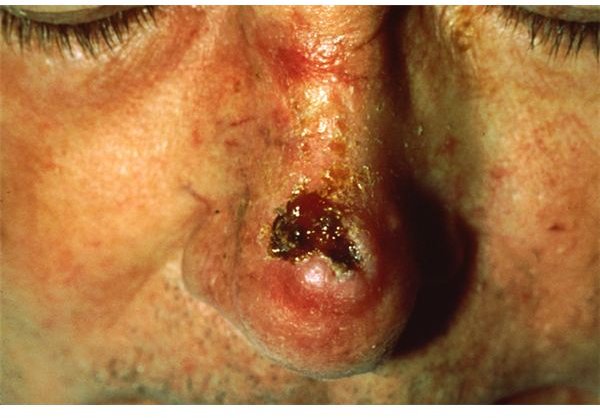Squamous Cell Carcinoma Appearance
Overview
Squamous cell carcinoma, a type of skin cancer, develops in the squamous cells. Squamous cells form the surface of the skin. Sun damage to these cells increase the likelihood that this cancer will occur. Squamous cell carcinoma appearance is distinguishable from other forms of carcinoma.
Images
Variations of Appearance
Squamous cell carcinoma most often occurs in sun damaged areas of the skin, but it is possible to have it appear on other parts of the body.
The following are variations in the appearance of squamous cell carcinoma:
- Anus - Ulcerated sore or red patch.
- Vagina - Bleeding, discharge or pain in the vaginal area.
- Mouth - Flat or ulcerated sore.
- Face, arms, neck, hands, and ears - Red nodule that is firm. Lesion that is flat with a scaly crust
- Lower lip - Red nodule that is firm.
- Scar - Raised area or ulcer of the skin.
- Cuts - Do not heal within 2 weeks.
Once squamous cell carcinoma has advanced there may be masses present. If the mass occurs in the head or neck, there may be a sore throat or ear infection that accompanies it as a symptom.
The above symptoms can be indications of other diseases or infections as well. The symptoms should be discussed with a medical professional promptly so that further examinations can be completed, such as visual examination and biopsy.
Self-skin Examination
The ABCDE method of self-skin examination is recommended by the American Academy of Dermatology. Squamous cell carcinoma can be suspected if a mole has the following:
- A - Asymmetrical shape. The asymmetrical shape may be in either shape or texture.
- B - Border. Irregular border, such as scalloped or notched.
- C - Color. Color that is not uniform throughout the mole, such as lighter and darker pigment.
- D - Diameter. Larger than 6 millimeters or that changes over time.
- E - Evolving. Changes in appearance such as shape, size or symptoms.
By performing self-skin examinations on a monthly basis an individual can recognize changes in the appearance of skin and moles. A mole that has any of the ABCDE characteristics should be brought to the attention of a medical professional so further examination can be performed.
By detecting changes in cells with a squamous cell carcinoma appearance and receiving treatment early, there is a high likelihood of successful treatment. Without early detection, it is possible for the carcinoma to spread. If this occurs, treatment may be more difficult depending on the area that it spreads to. Even with successful treatment of squamous cell carcinoma, there is still a possibility of recurrence in either the same or different area making self-examination crucial.
References
Mayo Clinic: Skin Cancer - https://www.mayoclinic.com/health/skin-cancer/DS00190
Skin Care Foundation: Squamous Cell Carcinoma - https://www.skincancer.org/squamous-cell-carcinoma/
